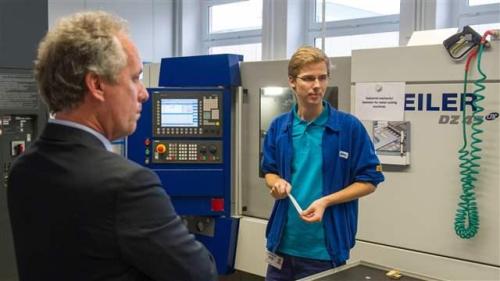German-style apprenticeship programs have attracted private sector interest as well as healthy skepticism in the United States as leaders search for an antidote to skills gaps and stagnating incomes.
After returning last week from Munich to see the program in action, I believe the United States can import some of its most valuable lessons.
Our visits to Siemens and Seidenader, a mid-sized Munich-area producer of high-tech inspection machines for the worldwide pharmaceutical industry, revealed that the German model of dual learning (blending classroom instruction with hands-on work) is much more fluid than commonly perceived. Rather than limit teenagers’ life choices, the system provides young people with opportunities to attain a college degree or management training alongside paid, practical work experience. Apprentices at Seidenader also have a choice of many occupations, not strictly in production but also in sales, accounting, and procurement.
As American states, local leaders, and employers work to build a competitive workforce and reduce high youth unemployment, they can’t necessarily adopt all the mechanics of Germany’s 500 year-old apprenticeship model. But they can embrace the values the program reflects. Here are three that stand out:
- Germans prepare young workers for meaningful careers, not solely a diploma. The U.S. culture places a premium on a college education, and celebrates a single credential—the bachelor’s degree—as the best predictor of success. In contrast, Germans look beyond the educational system to help every young person be a productive member of their advanced economy. They introduce the concept of careers to students and their families as early as kindergarten to stem the chances of school dropouts later. They knit together educational and vocational programs and practical experience to build multiple pathways to both blue collar and white collar careers. They translate that to 349 nationally recognized occupations with certificates that are routinely updated to keep pace with the changing needs of industry.
- Regional chambers of commerce in Germany play a critical role in skills development. While the United States is blessed with a wide range of business and economic development groups, regional chambers in Germany are arguably even better at being critical partners for enhancing economic competitiveness. The German chambers, which firms are required by law to join, excel at organizing industrial consortiums, particularly to help articulate the direction of workforce curriculums and standards and to facilitate firms’ participation in apprenticeship programs. German chambers also make skills development a core function of economic development, with dedicated staff and programs.
- German firms invest in and commit to current and future workers. U.S. firms often lament the inability to find skilled workers. In Germany, the motto is “If you can’t buy it, you must make it.” German firms not only invest in the latest technologies and equipment, they also invest in a skilled labor force. Seidenader regularly hires graduates from its apprenticeship program, and works closely with trainees’ classroom instructors to make sure every young adult successfully passes their programs and attains relevant credentials. Meanwhile, a recent Harvard Business School survey of their alumni found that just 7 percent reported that their firms were “deeply involved” in public education, and only 27 percent engaged with institutions like community colleges to prepare students with relevant workforce skills. The conclusion was that U.S. businesses needed to better partner with educators and skills trainers to help raise workers’ living standards and solve the skills problem.
To be fair, many national, state, and local experiments are underway in the United States that embrace industry-driven workforce training, partnerships between employers and post-secondary institutions, and career pathways built around nationally-recognized credentials. Furthermore, German-style apprenticeships are beginning to take root in states likes South Carolina and Michigan, and metro areas like Louisville-Lexington, Kentucky.
As we closed a roundtable discussion at Seidenader, an official at the education ministry for the city of Munich whispered, “You know, the dual system began as a local pilot in Munich before it became a national program.” Bottom-up innovation—now that’s advice we can act on.









Commentary
Importing the German Approach to Career Building
December 1, 2014